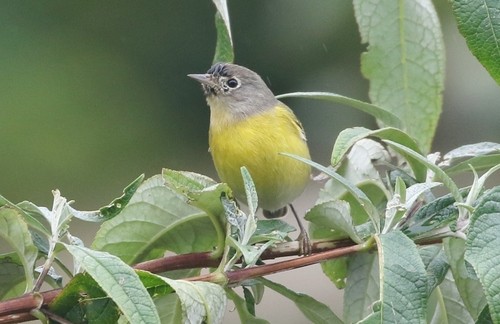Nashville Warbler
A species of Leiothlypis Warblers Scientific name : Leiothlypis ruficapilla Genus : Leiothlypis Warblers
Nashville Warbler, A species of Leiothlypis Warblers
Botanical name: Leiothlypis ruficapilla
Genus: Leiothlypis Warblers
Content
Description People often ask General Info
 Photo By silversea_starsong , used under CC-BY-NC-4.0 /Cropped and compressed from original
Photo By silversea_starsong , used under CC-BY-NC-4.0 /Cropped and compressed from original Description
The Nashville warbler is a small warbler. Both male and female Nashville warblers have a gray head fading into a greenish back and wings, a white belly and a yellow throat and breast. They have a complete white eye ring, no wing bars, and a thin pointed black bill. Adult males have a rusty brown patch on their crown, which is usually hard to see and often covered by gray feathers. Males will raise it slightly when agitated. Females and immature birds have a duller olive-grey head, and less bold yellow on their throat. The Nashville warbler is closely related to Virginia's warbler, Lucy's warbler, and the Colima warbler, the four sharing generally similar plumage. Measurements: Length: 4.3-5.1 in (11-13 cm) Weight: 0.2-0.5 oz (6.7-13.9 g) Wingspan: 6.7-7.9 in (17-20 cm) The song of the nominate subspecies consists of a rapid seewit-seewit-seewit-ti-ti-ti. Males sing from open perches on the nesting territory. The call sounds like a high seet. Western birds of the race ridgwayi have a slightly lower-pitched, richer song, and a sharper call note. 
Size
12 cm (4.75 in)
Colors
Green
Yellow
Gray
White
Life Expectancy
7 years
Nest Placement
Ground
Clutch Size
4 - 5 eggs
Incubation Period
1 brood
Number of Broods
11 - 12 days
Nestling Period
9 - 11 days
Feeding Habits
Nashville Warbler's diet primarily consists of insects and arthropods, including flies, grasshoppers, leafhoppers, caterpillars, beetles, and spruce budworms. Occasionally, overwintering individuals consume suet cakes in southern United States.
Habitat
Nashville Warbler predominantly reside in open mixed woods, bogs, and second-growth shrubby habitats, with variances between eastern mixed-species forests and western brushy black-oak groves, often at elevations of 3,300 to 5,400 feet. Post-breeding, they occupy regenerating clearcuts. During winter, their habitat shifts to tropical forests and suburban gardens, with a preference for low, open deciduous areas. Migratory paths lead them through various brushy habitats, including drier regions in the West.
Nest Behavior
The female nashville Warbler is solely responsible for building the nest over a 7-9 day period.
Nest Characteristics
Nashville Warbler's nest is a concealed ground-level structure concealed among bushes or tree bases, well-camouflaged, and constructed of moss, bark strips, and grasses, with an inner lining of fine grasses, pine needles, and animal hair. It measures approximately 3.5 inches in width and 2 inches in depth, featuring a neat cup shape.
Dite type
Insectivorous
People often ask
General Info
Feeding Habits
Bird food type
Bird Feeder Type

Small Tube Feeder

Platform
Sounds
Call
Recording location: Mexico
Song
Recording location: United States
Behavior
Nashville Warbler exhibits methodical movements while foraging, often accompanied by tail flicking. They skillfully navigate through treetops, inspecting undersides of leaves for insects. Eastern nashville Warbler males typically vocalize from the middle to lower understory, while their western counterparts sing from elevated, sometimes charred perches. During breeding, nashville Warbler form seasonally monogamous pairs, showing fidelity without signs of extra-pair copulation or polygamy. Both sexes partake in chick rearing, with females primarily incubating and males assisting. Post-breeding, nashville Warbler are social creatures, participating in large mixed-species flocks for migration and overwintering.
Distribution Area
Nashville warblers breed in two distinct areas, one in Canada and the northeastern United States, and another in the western United States. The northeastern part of its range extends from Côte-Nord and Cape Breton Island in eastern Canada to central Alberta. For the most part, it only breeds between about 52 and 45.5 degrees north, but it is also found less commonly in the Appalachians of Pennsylvania and West Virginia. Although named after Nashville, Tennessee, the Nashville warbler only visits that area during migration. They migrate to southernmost Texas and California, mid-Mexico, and the northernmost parts of Central America (Guatemala and El Salvador) in winter. In their breeding range, they prefer open mixed woods and bog habitats. 
Species Status
Not globally threatened.
Scientific Classification
Phylum
Chordates Class
Birds Order
Perching birds Family
New world warblers Genus
Leiothlypis Warblers Species
Nashville Warbler